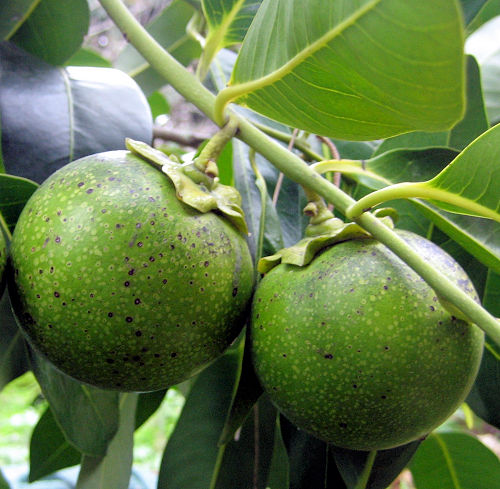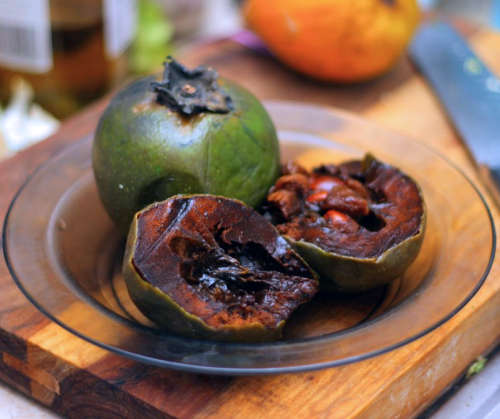Botanical Overview
Black Sapote is a member of the Ebony family (Ebenaceae), which contains over 790 Diospyros
species, and is closely related to persimmons.
It naturally grows in the tropics and subtropics at altitudes from sea level to
6000' (1.8km) high.
It barely survives freezing, requires moist soil, and can survive in desert heat with proper
care.
When the fruit is eaten very ripe, after the pulp has become soft and dark brown,
Black Sapote is said to have the consistency and flavor of chocolate, or possibly date,
pudding.
The common name "Sapote" actually means any roundish, soft, edible fruit native to Mexico
and Central America.
Black Sapote is not related to White Sapote, Yellow Sapote, nor Mamey Sapote.
Description
Form: Tree.
Lifespan: Perennial.
Leaf retention: Evergreen.
Growth rate:
Slow.
Mature Size: 20-80' (6-25m) high unless trimmed lower.
Flowers:
Tubular, usually with four lobes, yellowish-white, with persistent green sepals.
Some trees may have only male flowers, which appear in clusters and produce no fruit.
Other trees will have bisexual flowers or female flowers.
A few trees will have both male and female flowers.
Bloom: Spring.
Self-fruitful:
The flowers may or may not be self-compatible, depending on the cultivar.
Having two trees improves fruit set.
Years before fruiting:
5-6 from seed, 2-3 when grafted.
Fruit:
Oblate to nearly round in shape, the inedible, smooth thin skin turns from bright green to
olive-green, then muddy green when fully ripe.
The pulp is custard-like, very dark brown at maturity, with a mild, sweet flavor that has
been compared to chocolate or date.
The flavor may vary between individual trees depending on soil, sun, and water.
The fruit can be seedless, or contain one to ten flat, brown seeds.
Months for fruit to ripen: 6.
The fruit will have the best flavor when harvested soft on the tree at the olive green stage
so it can ripen indoors in 2-6 days.
For shipping, the fruit should be picked when bright green, and will ripen within 10 days.
If fruit remain on the tree until muddy green, they will likely fall to the ground and break
open, making a mess.
Storage after harvest:
Once soft and fully mature, the fruit must be eaten immediately or processed into food.
Leaves:
Green, oblong, glossy, alternating on the stem.
Stems:
New stems are green. Brown flaky bark develops with age.
These trees can withstand strong winds when branches are pruned to be open to the wind.
Roots:
The trees sold in nurseries are normally grafted.
This tree has a taproot which makes it difficult to transplant.
The root volume will correspond to the size of the tree.
Wildlife:
The flowers attract bees.
The fruit attracts many species of birds, small mammals that climb, and large mammals that
eat fruit fallen to the ground.
Toxic / Danger:
The unripe fruit is toxic.
Origin:
Mexico, Central America, and Columbia.
Cultivation and Uses
USDA hardiness zones:
10-12. Young trees are killed at 30°F (-1°C).
Mature trees are killed at 28°F (-2°C).
Cover this tree with frost cloth when temperatures are near freezing.
Chill hours:
Less than 100 hours below 50°F (10°C).
Heat tolerant:
The water amount must be doubled when temperatures are over 105°F (40°C).
Drought tolerant: No.
Sun:
Full sun to light shade.
Planting:
These trees do best in full sun and should be spaced 25' (7.6m) from other trees and
structures.
Nearby trees with well developed roots may rob the soil surrounding this tree of moisture
and inhibit its growth.
Avoid low-lying areas where cold air collects.
Avoid power lines because the tree will eventually grow above them if not trimmed 8-10'
(2.4-3m) high yearly.
Black Sapote can be grown in containers, but must be repotted into a larger container every
few years.
Soil:
This tree adapts to many soil types within the constraints of being well draining, moist,
and with pH 6.1-8.5 (slightly acidic to alkaline).
Root rot has been reported in poorly draining soils.
Fertilize:
Apply organic fertilizer mid-winter, mid-spring and late summer.
A slow-release 10-10-10 fertilizer can be used mid-winter.
Water after becoming established:
Deep water weekly, tapering off to once a month in winter accounting for rain.
These trees are tolerant of brief flooding.
Mulch:
Provide a 1-1.5' (30-46cm) deep layer of straw over the root area in the desert to retain
soil moisture and shield the roots from temperature extremes.
First Year Care:
Water every two to three days until winter, then once a month depending on rain.
Provide afternoon shade.
Cover with frost cloth when temperatures are near freezing.
Prune:
The tree should be pruned to a maximum of 8-10' (2.4-3m) high every winter for ease of
harvesting.
That height will also allow frost cloth to be placed over it every year when temperatures
are near freezing.
Flowers appear on new growth.
Litter:
Abundant, soft messy fruit if not harvested.
Propagation:
Air layering and grafting. Seeds do not breed true to the original plant.
Black Sapote can successfully be grafted onto Asian persimmon: Diospyros kaki.
Pests:
This species is relatively pest free.
Uses:
Edible fruit. The fruit pulp is best eaten fresh when soft and dark brown.
Cream, honey, orange juice, or vanilla can be mixed in to complement the flavor.
The pulp can also be added to bread dough, used in pie filling, or used as a flavoring for
ice cream.
Comments
One Spanish common name is Zapote Prieto.
Black Sapote is closely related to
Asian Persimmon: Diospyros kaki.
Do you have additional information or a different experience for this plant that you would
like to share? Email info@GardenOracle.com. All contributions are welcome and appreciated.



